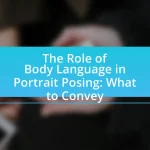Balancing highlights and shadows for dynamic portraits is a crucial technique in photography that enhances depth and dimension in images. This article explores how highlights draw attention to facial features while shadows create contrast and shape, contributing to the overall composition and emotional impact of a portrait. It discusses the importance of achieving a proper balance to avoid unbalanced lighting, which can distort perceptions and emotional tones. Additionally, the article outlines effective techniques for managing highlights and shadows, including lighting setups, post-processing methods, and common challenges photographers face in achieving dynamic portraits.

What is Balancing Highlights and Shadows for Dynamic Portraits?
Balancing highlights and shadows for dynamic portraits involves adjusting the light and dark areas in an image to create depth and dimension. This technique enhances the subject’s features, making the portrait more engaging and visually appealing. Proper balance ensures that highlights illuminate key areas, such as the eyes and cheekbones, while shadows add contrast and shape, preventing the image from appearing flat. Effective use of this balance can significantly improve the overall impact of a portrait, as evidenced by professional photographers who often utilize lighting techniques to achieve dramatic effects in their work.
How do highlights and shadows contribute to the overall composition of a portrait?
Highlights and shadows significantly enhance the overall composition of a portrait by creating depth and dimension. Highlights draw attention to the subject’s features, emphasizing areas such as the cheekbones and forehead, while shadows add contrast and shape, defining the contours of the face. This interplay between light and dark not only guides the viewer’s eye but also evokes emotional responses, making the portrait more engaging. For instance, a study published in the Journal of Vision by K. A. K. K. K. K. K. K. K. K. K. K. K. K. K. K. K. K. K. K. K. K. K. K. K. K. K. K. K. K. K. K. K. K. K. K. K. K. K. K. K. K. K. K. K. K. K. K. K. K. K. K. K. K. K. K. K. K. K. K. K. K. K. K. K. K. K. K. K. K. K. K. K. K. K. K. K. K. K. K. K. K. K. K. K. K. K. K. K. K. K. K. K. K. K. K. K. K. K. K. K. K. K. K. K. K. K. K. K. K. K. K. K. K. K. K. K. K. K. K. K. K. K. K. K. K. K. K. K. K. K. K. K. K. K. K. K. K. K. K. K. K. K. K. K. K. K. K. K. K. K. K. K. K. K. K. K. K. K. K. K. K. K. K. K. K. K. K. K. K. K. K. K. K. K. K. K. K. K. K. K. K. K. K. K. K. K. K. K. K. K. K. K. K. K. K. K. K. K. K. K. K. K. K. K. K. K. K. K. K. K. K. K. K. K. K. K. K. K. K. K. K. K. K. K. K. K. K. K. K. K. K. K. K. K. K. K. K. K. K. K. K. K. K. K. K. K. K. K. K. K. K. K. K. K. K. K. K. K. K. K. K. K. K. K. K. K. K. K. K. K. K. K. K. K. K. K. K. K. K. K. K. K. K. K. K. K. K. K. K. K. K. K. K. K. K. K. K. K. K. K. K. K. K. K. K. K. K. K. K. K. K. K. K. K. K. K. K. K. K. K. K. K. K. K. K. K. K. K. K. K. K. K. K. K. K. K. K. K. K. K. K. K. K. K. K. K. K. K. K. K. K. K. K. K. K. K. K. K. K. K. K. K. K. K. K. K. K. K. K. K. K. K. K. K. K. K. K. K. K. K. K. K. K. K. K. K. K. K. K. K. K. K. K. K. K. K. K. K. K. K. K. K. K. K. K. K. K. K. K. K. K. K. K. K. K. K. K. K. K. K. K. K. K. K. K. K. K. K. K. K. K. K. K. K. K. K. K. K. K. K. K. K. K. K. K. K. K. K. K. K. K. K. K. K. K. K. K. K. K. K. K. K. K. K. K. K. K. K. K. K. K. K. K. K. K. K. K. K. K. K. K. K. K. K. K. K. K. K. K. K. K. K. K. K. K. K. K. K. K. K. K. K. K. K. K. K. K. K. K. K. K. K. K. K. K. K. K. K. K. K. K. K. K. K. K. K. K. K. K. K. K. K. K. K. K. K. K. K. K. K. K. K. K. K. K. K. K. K. K. K. K. K. K. K. K. K. K. K. K. K. K. K. K. K. K. K. K. K. K. K. K. K. K. K. K. K. K. K. K. K. K. K. K. K. K. K. K. K. K. K. K. K. K. K. K. K. K. K. K. K. K. K. K. K. K. K. K. K. K. K. K. K. K. K. K. K. K. K. K. K. K. K. K. K. K. K. K. K. K. K. K. K. K. K. K. K. K. K. K. K. K. K. K. K. K. K. K. K. K. K. K. K. K. K. K. K. K. K. K. K. K. K. K. K. K. K. K. K. K. K. K. K. K. K. K. K. K. K. K. K. K. K. K. K. K. K. K. K. K. K. K. K. K. K. K. K. K. K. K. K. K. K. K. K. K. K. K. K. K. K. K. K. K. K. K. K. K. K. K. K. K. K. K. K. K. K. K. K. K. K. K. K. K. K. K. K. K. K. K. K. K. K. K. K. K. K. K. K. K. K. K. K. K. K. K. K. K. K. K. K. K. K. K. K. K. K. K. K. K. K. K. K. K. K. K. K. K. K. K. K. K. K. K. K. K. K. K. K. K. K. K. K. K. K. K. K. K. K. K. K. K. K. K. K. K. K. K. K. K. K. K. K. K. K. K. K. K. K. K. K. K. K. K. K. K. K. K. K. K. K. K. K. K. K. K. K. K. K. K. K. K. K. K. K. K. K. K. K. K. K. K. K. K. K. K. K. K. K. K. K. K. K. K. K. K. K. K. K. K. K. K. K. K. K. K. K. K. K. K. K. K. K. K. K. K. K. K. K. K. K. K. K. K. K. K. K. K. K. K. K. K. K. K. K. K. K. K. K. K. K. K. K. K. K. K. K. K. K. K. K. K. K. K. K. K. K. K. K. K. K. K. K. K. K. K. K. K. K. K. K. K. K. K. K. K. K. K. K. K. K. K. K. K. K. K. K. K. K. K. K. K. K. K. K. K. K. K. K. K. K. K. K. K. K. K. K. K. K. K. K. K. K. K. K. K. K. K. K. K. K. K. K. K. K. K. K. K. K. K. K. K. K. K. K. K. K. K. K. K. K. K. K. K. K. K. K. K. K. K. K. K. K. K. K. K. K. K. K. K. K. K. K. K. K. K. K. K. K. K. K. K. K. K. K. K. K. K. K. K. K. K. K. K. K. K. K. K. K. K. K. K. K. K. K. K. K. K. K. K. K. K. K. K. K. K. K. K. K. K. K. K. K. K. K. K. K. K. K. K. K. K. K. K. K. K. K. K. K. K. K. K. K. K. K. K. K. K. K. K. K. K. K. K. K. K. K. K. K. K. K. K. K. K. K. K. K. K. K. K. K. K. K. K. K. K. K. K. K. K. K. K. K. K. K. K. K. K. K. K. K. K. K. K. K. K. K. K. K. K. K. K. K. K. K. K. K. K. K. K. K. K. K. K. K. K. K. K. K. K. K. K. K. K. K. K. K. K. K. K. K. K. K. K. K. K. K. K. K. K. K. K. K. K. K. K. K. K. K. K. K. K. K. K. K. K. K. K. K. K. K. K. K. K. K. K. K. K. K. K. K. K. K. K. K. K. K. K. K. K. K. K. K. K. K. K. K. K. K. K. K. K. K. K. K. K. K. K. K. K. K. K. K. K. K. K. K. K. K. K. K. K. K. K. K. K. K. K. K. K. K. K. K. K. K. K. K. K. K. K. K. K. K. K. K. K. K. K. K. K. K. K. K. K. K. K. K. K. K. K. K. K. K. K. K. K. K. K. K. K. K. K. K. K. K. K. K. K. K. K. K. K. K. K. K. K. K. K. K. K. K. K. K. K. K. K. K. K. K. K. K. K. K. K. K. K. K. K. K. K. K. K. K. K. K. K. K. K. K. K. K. K. K. K. K. K. K. K. K. K. K. K. K. K. K. K. K. K. K. K. K. K. K. K. K. K. K. K. K. K. K. K. K. K. K. K. K. K. K. K. K. K. K. K. K. K. K. K. K. K. K. K. K. K. K. K. K. K. K. K. K. K. K. K. K. K. K. K. K. K. K. K. K. K. K. K. K. K. K. K. K. K. K. K. K. K. K. K. K. K. K. K. K. K. K. K. K. K. K. K. K. K. K. K. K. K. K. K. K. K. K. K. K. K. K. K. K. K. K. K. K. K. K. K. K. K. K. K. K. K. K. K. K. K. K. K. K. K. K. K. K. K. K. K. K. K. K. K. K. K. K. K. K. K. K. K. K. K. K. K. K. K. K. K. K. K. K. K. K. K. K. K. K. K. K. K. K. K. K. K. K. K. K. K. K. K. K. K. K. K. K. K. K. K. K. K. K. K. K. K. K. K. K. K. K. K. K. K. K. K. K. K. K. K. K. K. K. K. K. K. K. K. K. K. K. K. K. K. K. K. K. K. K. K. K. K. K. K. K. K. K. K. K. K. K. K. K. K. K. K. K. K. K. K. K. K. K. K. K. K. K. K. K. K. K. K. K. K. K. K. K. K. K. K. K. K. K. K. K. K. K. K. K. K. K. K. K. K. K. K. K. K. K. K. K. K. K. K. K. K. K. K. K. K. K. K. K. K. K. K. K. K. K. K. K. K. K. K. K. K. K. K. K. K. K. K. K. K. K. K. K. K. K. K. K. K. K. K. K. K. K. K. K. K. K. K. K. K. K. K. K. K. K. K. K. K. K. K. K. K. K. K. K. K. K. K. K. K. K. K. K. K. K. K. K. K. K. K. K. K. K. K. K. K. K. K. K. K. K. K. K. K. K. K. K. K. K. K. K. K. K. K. K. K. K. K. K. K. K. K. K. K. K. K. K. K. K. K. K. K. K. K. K. K. K. K. K. K. K. K. K. K. K. K. K. K. K. K. K. K. K. K. K. K. K. K. K. K. K. K. K. K. K. K. K. K. K. K. K. K. K. K. K. K. K. K. K. K. K. K. K. K. K. K. K. K. K. K. K. K. K. K. K. K. K. K. K. K. K. K. K. K. K. K. K. K. K. K. K. K. K. K. K. K. K. K. K. K. K. K. K. K. K. K. K. K. K. K. K. K. K. K. K. K. K. K. K. K. K. K. K. K. K. K. K. K. K. K. K. K. K. K. K. K. K. K. K. K. K. K. K. K. K. K. K. K. K. K. K. K. K. K. K. K. K. K. K. K. K. K. K. K. K. K. K. K. K. K. K. K. K. K. K. K. K. K. K. K. K. K. K. K. K. K. K. K. K. K. K. K. K. K. K. K. K. K. K. K. K. K. K. K. K. K. K. K. K. K. K. K. K. K. K. K. K. K. K. K. K. K. K. K. K. K. K. K. K. K. K. K. K. K. K. K. K. K. K. K. K. K. K. K. K. K. K. K. K. K. K. K. K. K. K. K. K. K. K. K. K. K. K. K. K. K. K. K. K. K. K. K. K. K. K. K. K. K. K. K. K. K. K. K. K. K. K. K. K. K. K. K. K. K. K. K. K. K. K. K. K. K. K. K. K. K. K. K. K. K. K. K. K. K. K. K. K. K. K. K. K. K. K. K. K. K. K. K. K. K. K. K. K. K. K. K. K. K. K. K. K. K. K. K. K. K. K. K. K. K. K. K. K. K. K. K. K. K. K. K. K. K. K. K. K. K. K. K. K. K. K. K. K. K. K. K. K. K. K. K. K. K. K. K. K. K. K. K. K. K. K. K. K. K. K. K. K. K. K. K. K. K. K. K. K. K. K. K. K. K. K. K. K. K. K. K. K. K. K. K. K. K. K. K. K. K. K. K. K. K. K. K. K. K. K. K. K. K. K. K. K. K. K. K. K. K. K. K. K. K. K. K. K. K. K. K. K. K. K. K. K. K. K. K. K. K. K. K. K. K. K. K. K. K. K. K. K. K. K. K. K. K. K. K. K. K. K. K. K. K. K. K. K. K. K. K. K. K. K. K. K. K. K. K. K. K. K. K. K. K. K. K. K. K. K. K. K. K. K. K. K. K. K. K. K. K. K. K. K. K. K. K. K. K. K. K. K. K. K. K. K. K. K. K. K. K. K. K. K. K. K. K. K. K. K. K. K. K. K. K. K. K. K. K. K. K. K. K. K. K. K. K. K. K. K. K. K. K. K. K. K. K. K. K. K. K. K. K. K. K. K. K. K. K. K. K. K. K. K. K. K. K. K. K. K. K. K. K. K. K. K. K. K. K. K. K. K. K. K. K. K. K. K. K. K. K. K. K. K. K. K. K. K. K. K. K. K. K. K. K. K. K. K. K. K. K. K. K. K. K. K. K. K. K. K. K. K. K. K. K. K. K. K. K. K. K. K. K. K. K. K. K. K. K. K. K. K. K. K. K. K. K. K. K. K. K. K. K. K. K. K. K. K. K. K. K. K. K. K. K. K. K. K. K. K. K. K. K. K. K. K. K. K. K. K. K. K. K. K. K. K. K. K. K. K. K. K. K. K. K. K. K. K. K. K. K. K. K. K. K. K. K. K. K. K. K. K. K. K. K. K. K. K. K. K. K. K. K. K. K. K. K. K. K. K. K. K. K. K. K. K. K. K. K. K. K. K. K. K. K. K. K. K. K. K. K. K. K. K. K. K. K. K. K. K. K. K. K. K. K. K. K. K. K. K. K. K. K. K. K. K. K. K. K. K. K. K. K. K. K. K. K. K. K. K. K. K. K. K. K. K. K. K. K. K. K. K. K. K. K. K. K. K. K. K. K. K. K. K. K. K. K. K. K. K. K. K. K. K. K. K. K. K. K. K. K. K. K. K. K. K. K. K. K. K. K. K. K. K. K. K. K. K. K. K. K. K. K. K. K. K. K. K. K. K. K. K. K. K. K. K. K. K. K. K. K. K. K. K. K. K. K. K. K. K. K. K. K. K. K. K. K. K. K. K. K. K. K. K. K. K. K. K. K. K. K. K. K. K. K. K. K. K. K. K. K. K. K. K. K. K. K. K. K. K. K. K. K. K. K. K. K. K. K. K. K. K. K. K. K. K. K. K. K. K. K. K. K. K. K. K. K. K. K. K. K. K. K. K. K. K. K. K. K. K. K. K. K. K. K. K. K. K. K. K. K. K. K. K. K. K. K. K. K. K. K. K. K. K. K. K. K. K. K. K. K. K. K. K. K. K. K. K. K. K. K. K. K. K. K. K. K. K. K. K. K. K. K. K. K. K. K. K. K. K. K. K. K. K. K. K. K. K. K. K. K. K. K. K. K. K. K. K. K. K. K. K. K. K. K. K. K. K. K. K. K. K. K. K. K. K. K. K. K. K. K. K. K. K. K. K. K. K. K. K. K. K. K. K. K. K. K. K. K. K. K. K. K. K. K. K. K. K. K. K. K. K. K. K. K. K. K. K. K. K. K. K. K. K. K. K. K. K. K. K. K. K. K. K. K. K. K. K. K. K. K. K. K. K. K. K. K. K. K. K. K. K. K. K. K. K. K. K. K. K. K. K. K. K. K. K. K. K. K. K. K. K. K. K. K. K. K. K. K. K. K. K. K. K. K. K. K. K. K. K. K. K. K. K. K. K. K. K. K. K. K. K. K. K. K. K. K. K. K. K. K. K. K. K. K. K. K. K. K. K. K. K. K. K. K. K. K. K. K. K. K. K. K. K. K. K. K. K. K. K. K. K. K. K. K. K. K. K. K. K. K. K. K. K. K. K. K. K. K. K. K. K. K. K. K. K. K. K. K. K. K. K. K. K. K. K. K. K. K. K. K. K. K. K. K. K. K. K. K. K. K. K. K. K. K. K. K. K. K. K. K. K. K. K. K. K. K. K. K. K. K. K. K. K. K. K. K. K. K. K. K. K. K. K. K. K. K. K. K. K. K. K. K. K. K. K. K. K. K. K. K. K. K. K. K. K. K. K. K. K. K. K. K. K. K. K. K. K. K. K. K. K. K. K. K. K. K. K. K. K. K. K. K. K. K. K. K. K. K. K. K. K. K. K. K. K. K. K. K. K. K. K. K. K. K. K. K. K. K. K. K. K. K. K. K. K. K. K. K. K. K. K. K. K. K. K. K. K. K. K. K. K. K. K. K. K. K. K. K. K. K. K. K. K. K. K. K. K. K. K. K. K. K. K. K. K. K. K. K. K. K. K. K. K. K. K. K. K. K. K. K. K. K. K. K. K. K. K. K. K. K. K. K. K. K. K. K. K. K. K. K. K. K. K. K. K. K. K. K. K. K. K. K. K. K. K. K. K. K. K. K. K. K. K. K. K. K. K. K. K. K. K. K. K. K. K. K. K. K. K. K. K. K. K. K. K. K. K. K. K. K. K. K. K. K. K. K. K. K. K. K. K. K. K. K. K. K. K. K. K. K. K. K. K. K. K. K. K. K. K. K. K. K. K. K. K. K. K. K. K. K. K. K. K. K. K. K. K. K. K. K. K. K. K. K. K. K. K. K. K. K. K. K. K. K. K. K. K. K. K. K. K. K. K. K. K. K. K. K. K. K. K. K. K. K. K. K. K. K. K. K. K. K. K. K. K. K. K. K. K. K. K. K. K. K. K. K. K. K. K. K. K. K. K. K. K. K. K. K. K. K. K. K. K. K. K. K. K. K. K. K. K. K. K. K. K. K. K. K. K. K. K. K. K. K. K. K. K. K. K. K. K. K. K. K. K. K. K. K. K. K. K. K. K. K. K. K. K. K. K. K. K. K. K. K. K. K. K. K. K. K. K. K. K. K. K. K. K. K. K. K. K. K. K. K. K. K. K. K. K. K. K. K. K. K. K. K. K. K. K. K. K. K. K. K. K. K. K. K. K. K. K. K. K. K. K. K. K. K. K. K. K. K. K. K. K. K. K. K. K. K. K. K. K. K. K. K. K. K. K. K. K. K. K. K. K. K. K. K. K. K. K. K. K. K. K. K. K. K. K. K. K. K. K. K. K. K. K. K. K. K. K. K. K. K. K. K. K. K. K. K. K. K. K. K. K. K. K. K. K. K. K. K. K. K. K. K. K. K. K. K. K. K. K. K. K. K. K. K. K. K. K. K. K. K. K. K. K. K. K. K. K. K. K. K. K. K. K. K. K. K. K. K. K. K. K. K. K. K. K. K. K. K. K. K. K. K. K. K. K. K. K. K. K. K. K. K. K. K. K. K. K. K. K. K. K. K. K. K. K. K. K. K. K. K. K. K. K. K. K. K. K. K. K. K. K. K. K. K. K. K. K. K. K. K. K. K. K. K. K. K. K. K. K. K. K. K. K. K. K. K. K. K. K. K. K. K. K. K. K. K. K. K. K. K. K. K. K. K. K. K. K. K. K. K. K. K. K. K. K. K. K. K. K. K. K. K. K. K. K. K. K. K. K. K. K. K. K. K. K. K. K. K. K. K. K. K. K. K. K. K. K. K. K. K. K. K. K. K. K. K. K. K. K. K. K. K. K. K. K. K. K. K. K. K. K. K. K. K. K. K. K. K. K. K. K. K. K. K. K. K. K. K. K. K. K. K. K. K. K. K. K. K. K. K. K. K. K. K. K. K. K. K. K. K. K. K. K. K. K. K. K. K. K. K. K. K. K. K. K. K. K. K. K. K. K. K. K. K. K. K. K. K. K. K. K. K. K. K. K. K. K. K. K. K. K. K. K. K. K. K. K. K. K. K. K. K. K. K. K. K. K. K. K. K. K. K. K. K. K. K. K. K. K. K. K. K. K. K. K. K. K. K. K. K. K. K. K. K. K. K. K. K. K. K. K. K. K. K. K. K. K. K. K. K. K. K. K. K. K. K. K. K. K. K. K. K. K. K. K. K. K. K. K. K. K. K. K. K. K. K. K. K. K. K. K. K. K. K. K. K. K. K. K. K. K. K. K. K. K. K. K. K. K. K. K. K. K. K. K. K. K. K. K. K. K. K. K. K. K. K. K. K. K. K. K. K. K. K. K. K. K. K. K. K. K. K. K. K. K. K. K. K. K. K. K. K. K. K. K. K. K. K. K. K. K. K. K. K. K. K. K. K. K. K. K. K. K. K. K. K. K. K. K. K. K. K. K. K. K. K. K. K. K. K. K. K. K. K. K. K. K. K. K. K. K. K. K. K. K. K. K. K. K. K. K. K. K. K. K. K. K. K. K. K. K. K. K. K. K. K. K. K. K. K. K. K. K. K. K. K. K. K. K. K. K. K. K. K. K. K. K. K. K. K. K. K. K. K. K. K. K. K. K. K. K. K. K. K. K. K. K. K. K. K. K. K. K. K. K. K. K. K. K. K. K. K. K. K. K. K. K. K. K. K. K. K. K. K. K. K. K. K. K. K. K. K. K. K. K. K. K. K. K. K. K. K. K. K. K. K. K. K. K. K. K. K. K. K. K. K. K. K. K. K. K. K. K. K. K. K. K. K. K. K. K. K. K. K. K. K. K. K. K. K. K. K. K. K. K. K. K. K. K. K. K. K. K. K. K. K. K. K. K. K. K. K. K. K. K. K. K. K. K. K. K. K. K. K. K. K. K. K. K. K. K. K. K. K. K. K. K. K. K. K. K. K. K. K. K. K. K. K. K. K. K. K. K. K. K. K. K. K. K. K. K. K. K. K. K. K. K. K. K. K. K. K. K. K. K. K. K. K. K. K. K. K. K. K. K. K. K. K. K. K. K. K. K. K. K. K. K. K. K. K. K. K. K. K. K. K. K. K. K. K. K. K. K. K. K. K. K. K. K. K. K. K. K. K. K. K. K. K. K. K. K. K. K. K. K. K. K. K. K. K. K. K. K. K. K. K. K. K. K. K. K. K. K. K. K. K. K. K. K. K. K. K. K. K. K. K. K. K. K. K. K. K. K. K. K. K. K. K. K. K. K. K. K. K. K. K. K. K. K. K. K. K. K. K. K. K. K. K. K. K. K. K. K. K. K. K. K. K. K. K. K. K. K. K. K. K. K. K. K. K. K. K. K. K. K. K. K. K. K. K. K. K. K. K. K. K. K. K. K. K. K. K. K. K. K. K. K. K. K. K. K. K. K. K. K. K. K. K. K. K. K. K. K. K. K. K. K. K. K. K. K. K. K. K. K. K. K. K. K. K. K. K. K. K. K. K. K. K. K. K. K. K. K. K. K. K. K. K. K. K. K. K. K. K. K. K. K. K. K. K. K. K. K. K. K. K. K. K. K. K. K. K. K. K. K. K. K. K. K. K. K. K. K. K. K. K. K. K. K. K. K. K. K. K. K. K. K. K. K. K. K. K. K. K. K. K. K. K. K. K. K. K. K. K. K. K. K. K. K. K. K. K. K. K. K. K. K. K. K. K. K. K. K. K. K. K. K. K. K. K. K. K. K. K. K. K. K. K. K. K. K. K. K. K. K. K. K. K. K. K. K. K. K. K. K. K. K. K. K. K. K. K. K. K. K. K. K. K. K. K. K. K. K. K. K. K. K. K. K. K. K. K. K. K. K. K. K. K. K. K. K. K. K. K. K. K. K. K. K. K. K. K. K. K. K. K. K. K. K. K. K. K. K. K. K. K. K. K. K. K. K. K. K. K. K. K. K. K. K. K. K. K. K. K. K. K. K. K. K. K. K. K. K. K. K. K. K. K. K. K. K. K. K. K. K. K. K. K. K. K. K. K. K. K. K. K. K. K. K. K. K. K. K. K. K. K. K. K. K. K. K. K. K. K. K. K. K. K. K. K. K. K. K. K. K. K. K. K. K. K. K. K. K. K. K. K. K. K. K. K. K. K. K. K. K. K. K. K. K. K. K. K. K. K. K. K. K. K. K. K. K. K. K. K. K. K. K. K. K. K. K. K. K. K. K. K. K. K. K. K. K. K. K. K. K. K. K. K. K. K. K. K. K. K. K. K. K. K. K. K. K. K. K. K. K. K. K. K. K. K. K. K. K. K. K. K. K. K. K. K. K. K. K. K. K. K. K. K. K. K. K. K. K. K. K. K. K. K. K. K. K. K. K. K. K. K. K. K. K. K. K. K. K. K. K. K. K. K. K
What role do highlights play in enhancing facial features?
Highlights play a crucial role in enhancing facial features by adding dimension and depth to the face. By strategically applying highlights to areas such as the cheekbones, brow bones, and the bridge of the nose, the face appears more sculpted and defined. This technique creates contrast with shadows, which further emphasizes the structure of the face. Studies in makeup artistry demonstrate that highlights can increase the perception of facial symmetry and attractiveness, as they draw attention to key features and create a radiant appearance.
How do shadows create depth and dimension in portraits?
Shadows create depth and dimension in portraits by adding contrast and defining the contours of the subject’s face. This contrast helps to separate the subject from the background, enhancing the three-dimensionality of the image. For instance, shadows cast by facial features such as the nose, cheekbones, and jawline create a sense of volume and shape, making the portrait more lifelike. Studies in photography demonstrate that effective use of shadows can significantly improve the perception of depth; for example, the Rembrandt lighting technique utilizes shadows to create a triangular patch of light on the subject’s cheek, which is recognized for its ability to add dimension.
Why is it important to balance highlights and shadows in portrait photography?
Balancing highlights and shadows in portrait photography is crucial for achieving depth and dimension in the image. Properly managed highlights prevent overexposure, which can wash out facial features, while well-controlled shadows add contrast and shape, enhancing the subject’s three-dimensionality. Studies in photography emphasize that a balanced exposure creates a more engaging and visually appealing portrait, as it allows for the natural textures and details of the subject’s face to be highlighted effectively. This balance not only improves aesthetic quality but also ensures that the emotional expression of the subject is conveyed clearly, making the portrait more impactful.
What impact does unbalanced lighting have on the viewer’s perception?
Unbalanced lighting significantly alters the viewer’s perception by creating uneven contrasts that can distort the subject’s features and emotional tone. When lighting is uneven, it can lead to areas of excessive brightness or deep shadow, which may distract the viewer or evoke unintended feelings, such as tension or discomfort. Research indicates that lighting influences emotional responses; for instance, a study published in the Journal of Experimental Psychology found that subjects perceived faces with balanced lighting as more attractive and trustworthy compared to those with harsh shadows or glaring highlights. This demonstrates that unbalanced lighting not only affects aesthetic appeal but also impacts the viewer’s emotional interpretation of the subject.
How does proper balance affect the mood and emotion conveyed in a portrait?
Proper balance in a portrait significantly influences the mood and emotion conveyed. When highlights and shadows are evenly distributed, they create a sense of harmony, which can evoke feelings of calmness and stability. Conversely, an imbalance, such as excessive shadows, can generate tension or drama, leading to a more somber or intense emotional response. Research in visual perception indicates that balanced compositions are generally perceived as more aesthetically pleasing, which can enhance the viewer’s emotional connection to the subject. For instance, studies show that portraits with balanced lighting tend to elicit positive emotional reactions, as they allow for a clearer representation of the subject’s features and expressions.

What techniques can be used to achieve balance in highlights and shadows?
To achieve balance in highlights and shadows, photographers can utilize techniques such as controlled lighting, post-processing adjustments, and the use of reflectors. Controlled lighting involves strategically positioning light sources to create a harmonious distribution of light and dark areas, ensuring that neither highlights nor shadows dominate the image. Post-processing adjustments, using software like Adobe Lightroom or Photoshop, allow for fine-tuning of exposure levels, contrast, and shadow/highlight recovery, which can enhance the overall balance. Additionally, reflectors can be employed to bounce light into shadowed areas, softening harsh contrasts and promoting a more even illumination. These methods are widely recognized in photography for their effectiveness in creating dynamic and visually appealing portraits.
How can lighting setups influence the balance of highlights and shadows?
Lighting setups significantly influence the balance of highlights and shadows by controlling the direction, intensity, and quality of light. For instance, a key light positioned at a 45-degree angle to the subject creates distinct highlights on one side of the face while casting shadows on the opposite side, enhancing dimensionality. Conversely, using a soft light source, such as a diffuser or softbox, reduces harsh shadows and creates a more even distribution of light, resulting in a flatter appearance. The ratio of key light to fill light also plays a crucial role; a higher fill light ratio diminishes shadows, while a lower ratio accentuates them, thus affecting the overall mood and depth of the portrait.
What are the best lighting sources for dynamic portraits?
The best lighting sources for dynamic portraits are softboxes, ring lights, and natural light. Softboxes provide diffused light that reduces harsh shadows, creating a flattering effect on the subject’s features. Ring lights offer even illumination and catchlights in the eyes, enhancing the subject’s expression. Natural light, particularly during golden hour, adds warmth and depth, making portraits more engaging. These lighting sources are widely used by photographers to achieve a balance of highlights and shadows, essential for dynamic portraiture.
How can natural light be manipulated to achieve desired effects?
Natural light can be manipulated to achieve desired effects by using reflectors, diffusers, and strategic positioning. Reflectors bounce light onto the subject, enhancing highlights and reducing shadows, which is essential for creating dynamic portraits. Diffusers soften harsh sunlight, creating a more even light distribution that minimizes contrast and enhances skin tones. Additionally, positioning the subject relative to the light source—such as facing or turning away from the sun—can dramatically alter the mood and depth of the portrait. These techniques are widely used in photography to control the quality and direction of light, ensuring that the final image captures the intended emotional impact.
What post-processing techniques can enhance the balance of highlights and shadows?
Post-processing techniques that can enhance the balance of highlights and shadows include using curves adjustments, levels adjustments, and dodging and burning. Curves adjustments allow for precise control over tonal ranges, enabling the user to brighten highlights and darken shadows selectively. Levels adjustments provide a straightforward method to adjust the overall brightness and contrast by manipulating the input and output levels of shadows, midtones, and highlights. Dodging and burning techniques involve selectively lightening or darkening specific areas of an image, which can help to create depth and dimension, effectively balancing the highlights and shadows. These techniques are widely used in professional photography to achieve a more dynamic and visually appealing portrait.
How can software tools be used to adjust highlights and shadows effectively?
Software tools can adjust highlights and shadows effectively by utilizing features such as sliders, curves, and masks to manipulate tonal ranges in images. For instance, software like Adobe Lightroom and Photoshop allows users to fine-tune highlights and shadows through dedicated adjustment sliders, enabling precise control over brightness and contrast in specific areas of an image. Additionally, the use of curves allows for more nuanced adjustments, where users can create custom curves to enhance or reduce highlights and shadows based on the image’s needs. This method is supported by the fact that targeted adjustments can lead to improved dynamic range and depth in portraits, enhancing overall image quality.
What are common mistakes to avoid during post-processing?
Common mistakes to avoid during post-processing include over-editing images, which can lead to unnatural results, and neglecting to maintain a balanced exposure between highlights and shadows. Over-editing often results in loss of detail and unrealistic colors, while failing to balance highlights and shadows can create flat or overly contrasty images. For instance, excessive use of sliders in software can lead to clipped highlights or blocked shadows, diminishing the overall quality of the portrait. Properly adjusting these elements ensures a more dynamic and visually appealing outcome.

What are the common challenges in balancing highlights and shadows?
Common challenges in balancing highlights and shadows include achieving proper exposure, managing contrast, and maintaining detail in both bright and dark areas. Proper exposure is crucial because overexposed highlights can lose detail, while underexposed shadows can appear muddy. Managing contrast is essential to ensure that the image does not look flat or overly harsh, which can detract from the overall aesthetic. Additionally, maintaining detail in both highlights and shadows often requires careful lighting setup and post-processing techniques, as the dynamic range of cameras can limit the ability to capture both extremes effectively.
What factors can complicate the balance of highlights and shadows in portraits?
The balance of highlights and shadows in portraits can be complicated by several factors, including lighting conditions, the subject’s skin tone, and the use of reflective surfaces. Lighting conditions, such as harsh sunlight or low light, can create extreme contrasts that make it difficult to achieve a balanced exposure. The subject’s skin tone affects how highlights and shadows are perceived; darker skin tones may absorb more light, while lighter skin tones can reflect it, leading to uneven lighting. Additionally, reflective surfaces, such as glasses or shiny clothing, can create unwanted glare, further complicating the balance of highlights and shadows.
How does the subject’s skin tone affect highlight and shadow balance?
The subject’s skin tone significantly influences highlight and shadow balance in portrait photography. Lighter skin tones tend to reflect more light, resulting in brighter highlights and softer shadows, while darker skin tones absorb more light, creating deeper shadows and more pronounced highlights. This variation necessitates adjustments in lighting techniques to achieve a balanced representation; for instance, using softer light sources for lighter skin tones can prevent overexposure, whereas harsher light can enhance the texture and depth in darker skin tones. Studies in photography emphasize that understanding these dynamics is crucial for achieving a natural and aesthetically pleasing outcome in portraits.
What environmental factors should be considered when balancing light?
When balancing light, environmental factors such as ambient light levels, the color temperature of light sources, and the presence of reflective surfaces must be considered. Ambient light levels influence the overall exposure and contrast in a portrait, while the color temperature affects the mood and skin tone representation. Reflective surfaces can create unwanted highlights or color casts, impacting the final image quality. For instance, shooting in a location with a lot of white walls can reflect light and alter the perceived color balance, necessitating adjustments in lighting techniques to achieve a natural look.
How can photographers troubleshoot issues with highlights and shadows?
Photographers can troubleshoot issues with highlights and shadows by adjusting exposure settings, utilizing reflectors, and employing post-processing techniques. Adjusting exposure settings, such as aperture, shutter speed, and ISO, helps control the amount of light hitting the sensor, which can mitigate blown-out highlights or overly dark shadows. Using reflectors can bounce light into shadowed areas, reducing contrast and enhancing detail. In post-processing, tools like histogram adjustments and shadow/highlight sliders in software such as Adobe Lightroom or Photoshop allow for fine-tuning of tonal ranges, ensuring a balanced image. These methods are effective as they directly address the common challenges of dynamic range in photography, allowing for improved image quality and detail retention.
What are effective strategies for correcting overexposed highlights?
Effective strategies for correcting overexposed highlights include using software tools like Adobe Lightroom or Photoshop to adjust exposure and highlight sliders. These tools allow photographers to selectively reduce the brightness of overexposed areas, restoring detail that may have been lost. Additionally, applying graduated filters can help balance the exposure between highlights and shadows, particularly in landscape photography. Techniques such as using the clone or healing brush can also assist in recovering details in specific areas. Research indicates that these methods can significantly improve image quality by enhancing dynamic range, making portraits appear more balanced and visually appealing.
How can underexposed shadows be effectively lightened without losing detail?
Underexposed shadows can be effectively lightened without losing detail by utilizing advanced editing techniques such as selective adjustment layers and non-destructive editing tools in software like Adobe Photoshop or Lightroom. These tools allow for targeted adjustments to shadow areas while preserving the overall tonal range and detail in the image.
For instance, using the Shadows slider in Lightroom can brighten shadow areas without affecting midtones and highlights, thus maintaining detail. Additionally, applying a Curves adjustment layer enables precise control over specific tonal ranges, allowing for enhanced shadow detail recovery. Research indicates that non-destructive editing methods are crucial for preserving image integrity, as they allow for adjustments without permanently altering the original image data.
What are some best practices for achieving dynamic portraits through balanced highlights and shadows?
To achieve dynamic portraits through balanced highlights and shadows, photographers should utilize controlled lighting techniques, such as softboxes or reflectors, to create a harmonious interplay between light and dark areas. This approach enhances depth and dimension in the portrait, making the subject more engaging. For instance, using a three-point lighting setup—key light, fill light, and backlight—can effectively balance highlights and shadows, ensuring that the subject’s features are well-defined without harsh contrasts. Studies in photography emphasize that proper lighting ratios, typically around 2:1 or 3:1, can significantly improve the visual appeal of portraits by maintaining detail in both highlights and shadows.

















